
Marjorie Ruth Blumberg Katz
Select- Parents: Louis Eliel Blumberg and Leah Schulman Blumberg
- Siblings: Herbert Blumberg
- Spouses: Ellis Robert Katz
- Children: Private, Private, and Private
- Gender: female
- Birthplace: Chattanooga, Tennessee
- Deathplace: Los Angeles, California
- Occupation: artist
- Wedding date: 1946-07-28
Marjorie Ruth Blumberg was born 3 Feb 1925 in Chattanooga, TN. Right off the bat, you may note, she was eager to perform. She was the daughter of Leah and Louis Blumberg and the sister of two-year older Herbert. The family lived, for a time on Missionary Ridge in Chattanooga, the scene of fierce fighting during the War Between The States.

Marjorie in front of a house, dressed to kill, April 23, 1942
It was all very natural and understandable...Marjorie Ruth simply couldn't stand still whenever music was playing. Here she is at the age of two, mandolin in hand and already doing the high kick, at three ready for recital to "Tip Toe Through The Tulips"
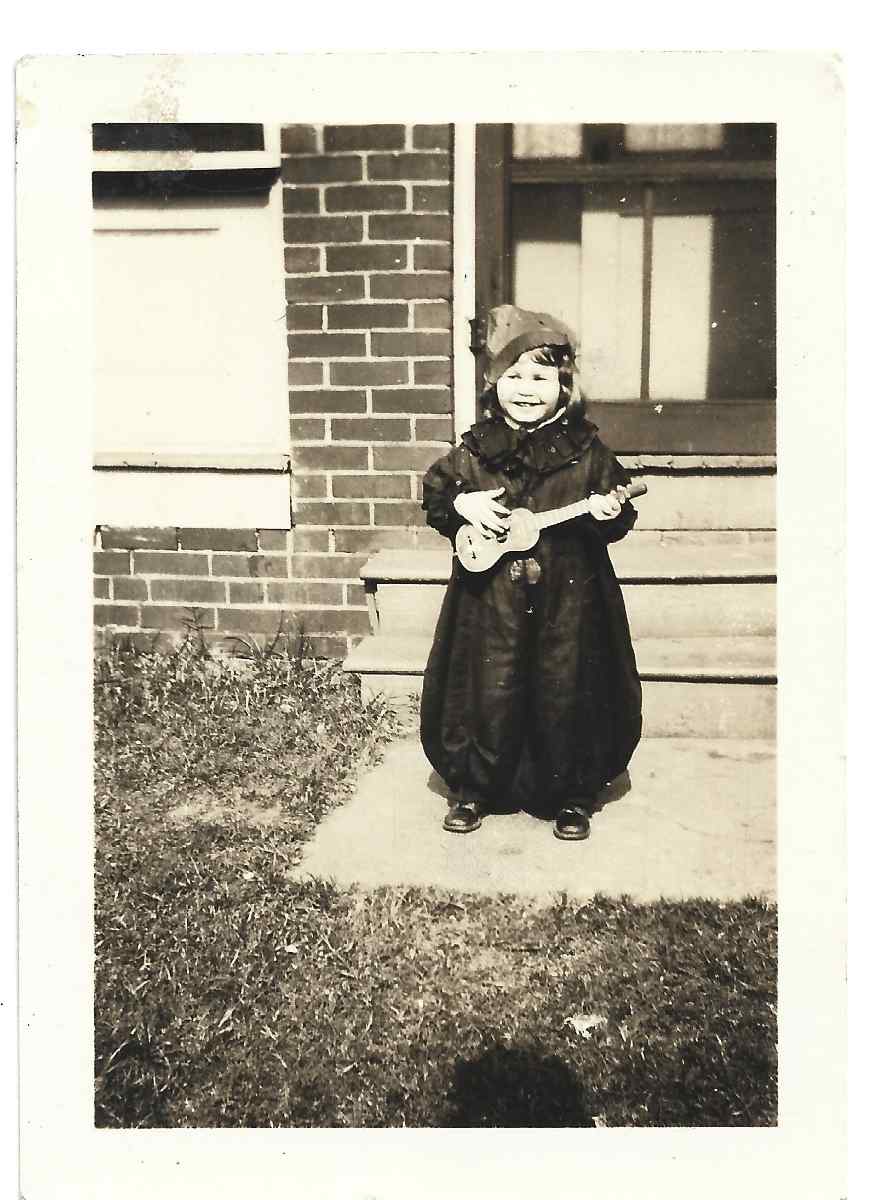
young Marjorie playing tip-toe through the tulips on mandolin
and then, at the age of five, dressed for her "Russian Dance".
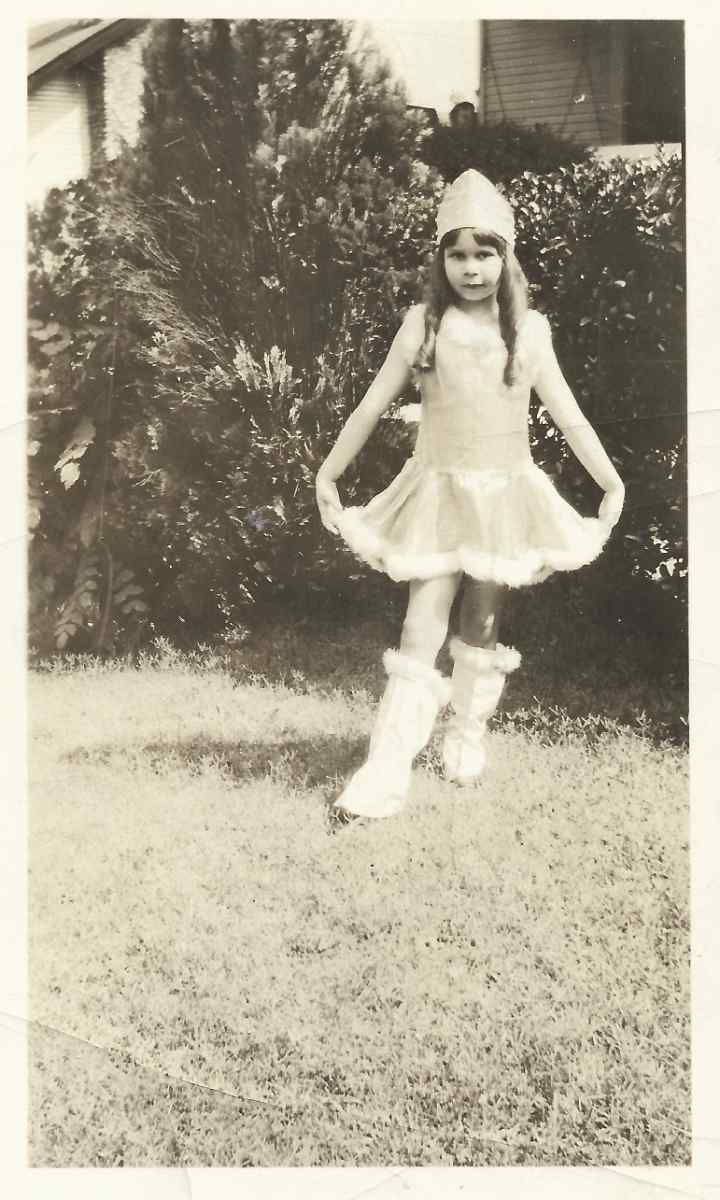
young Marjorie Katz, June 26 1931, 722 Cherry Street, Chattanooga, Tennessee, about to perform the russian dance.
Within a short time, the family had moved back to Chattanooga, then to Nashville and, later, to Roanoke, VA. It was in Roanoke that Marjorie Ruth grew through her teen years into a beautiful young lady, and graduated high school. She was active in the Young Judeans and had a very active social life, including weekend parties at Washington & Lee and VPI.
And...as you will note, Marjorie had more on her mind than boys and dates. She won honors for her essays (see inset from the Roanoke Times [BRK edit: and the essay is listed further down]) and is listed in the "American Jewish Yearbook, 1940-1941" And, as president of the Roanoke Young Judeans, she won a trip to the Young Judean Camp in Port Jervis, NY
From her earliest years, Marjorie Ruth had shown a talent and love of art; her portfolio yet contains some of her early sketches and drawings to enjoy. She wanted to study art at a top school and that school, as it happens, was in Richmond VA and known by the appellation, "Richmond Professional Institute, College of William and Mary" [RPI]. Marjorie Ruth entered college Sept 1942 and proceeded to have the time of her life…as well as to learn the techniques and processes of creating fine art.
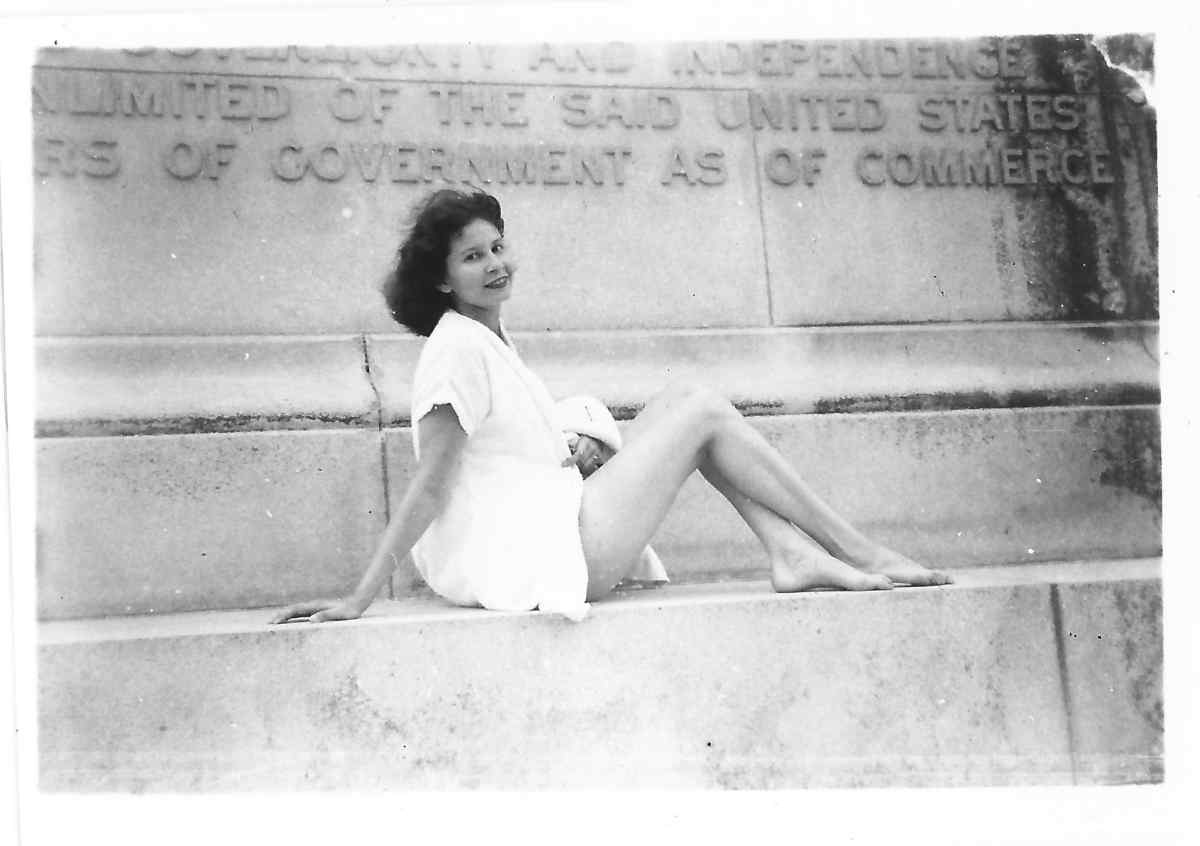
Marjorie posing on statue plinth
...But...it was not all about art!
At RPI, Marj met and roomed with Joan Shapiro (nee Harrison) who became her best friend and, later, maid of honor at her wedding: It was a most joyous time…dates, parties, wild dances (including a solo bacchanal to the "Bolero"). Being away from home for her first time, and "cutting loose", Marjorie Ruth decided she wanted to be known as "Marj" or "Marjorie", not "Ruth" as her family and friends had known her till college.
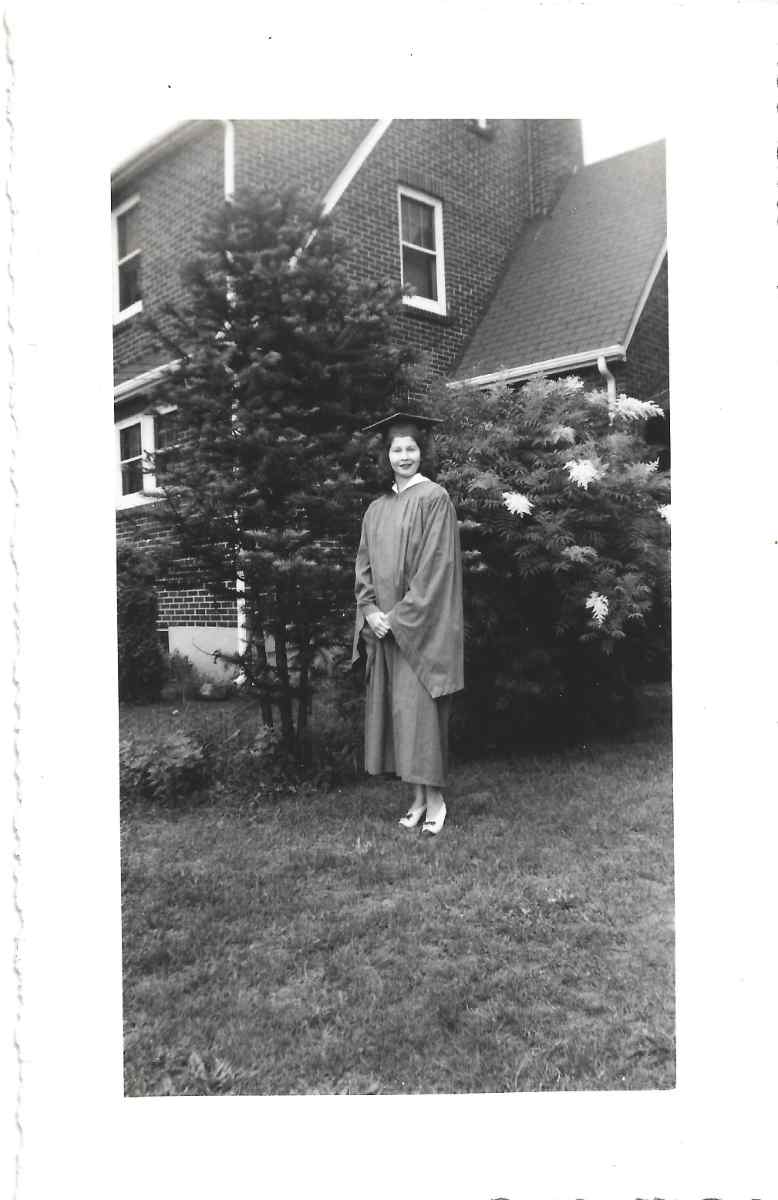
graduation picture Marjorie Katz July 6 1942
And it was there, a few months before her graduation that God took Ellis by the hand on a train ride from Hampton to Richmond for an afternoon tea party where his love would be among the group. And it was God's hand (helped by Joan) that told Marjorie to accept a date for the party because, at least, it meant a Sunday supper out. Well, as is often said, "the rest is history". Ellis was blown away when he saw that beautiful poised young lady in the checkered suit with a tam perched prettily atop her darling head. Early in March, on the third date, Ellis asked Marjorie to be his wife. But she did not acquiesce until weeks later. At her June graduation, with her parents and dear Aunt Rosetta present, Marjorie became engaged to Ellis…Glory Be !!!
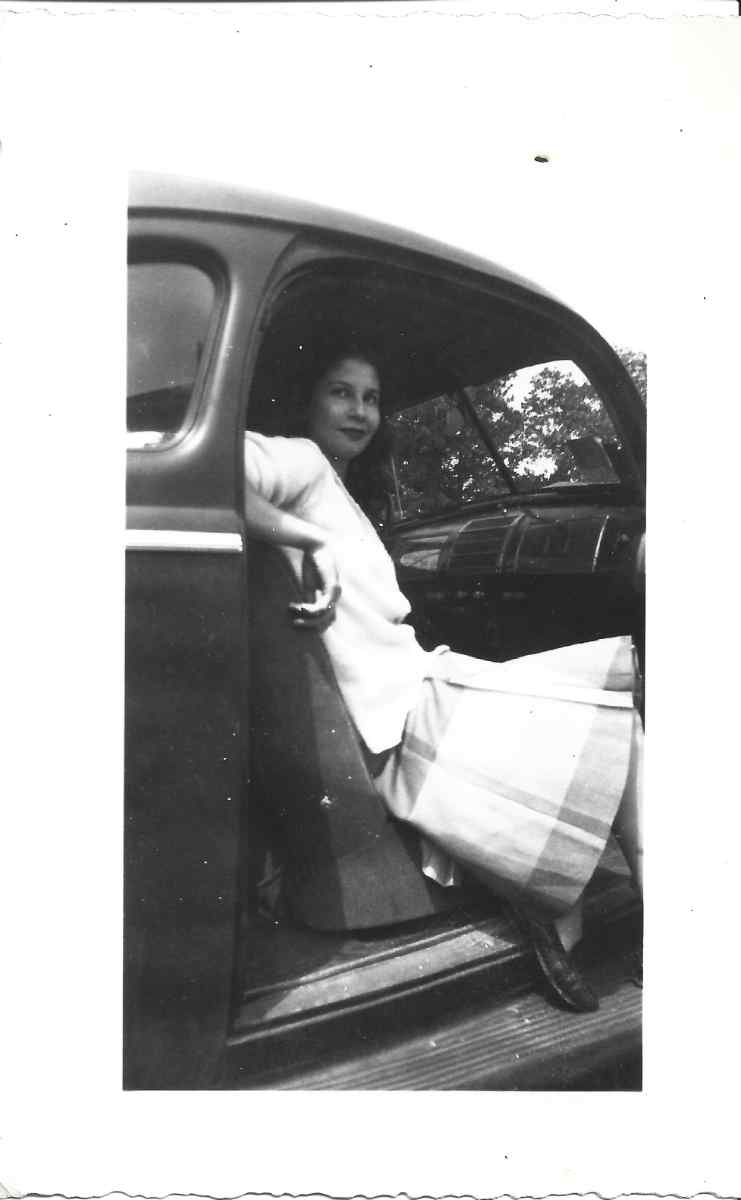
Marjorie in car
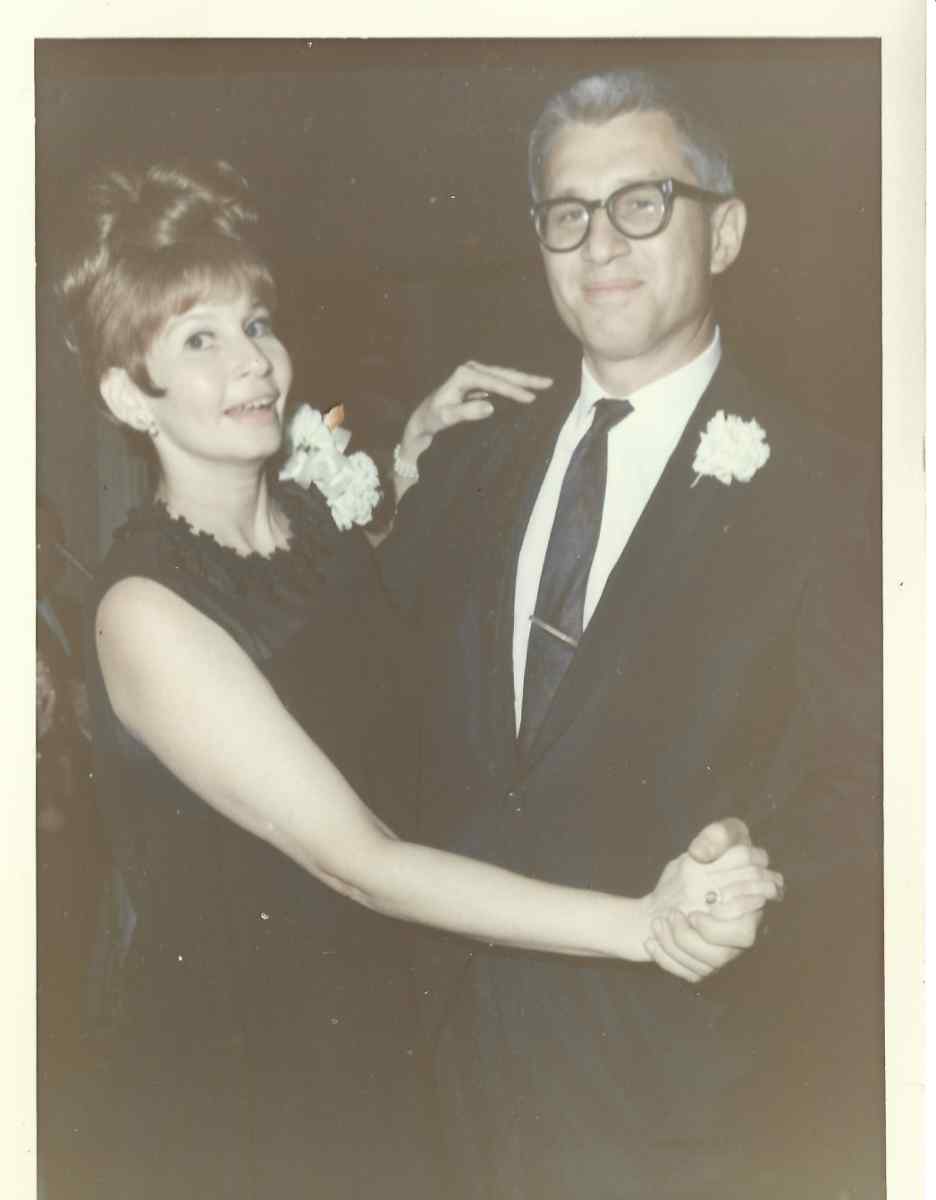
Ellis and Marjorie dancing
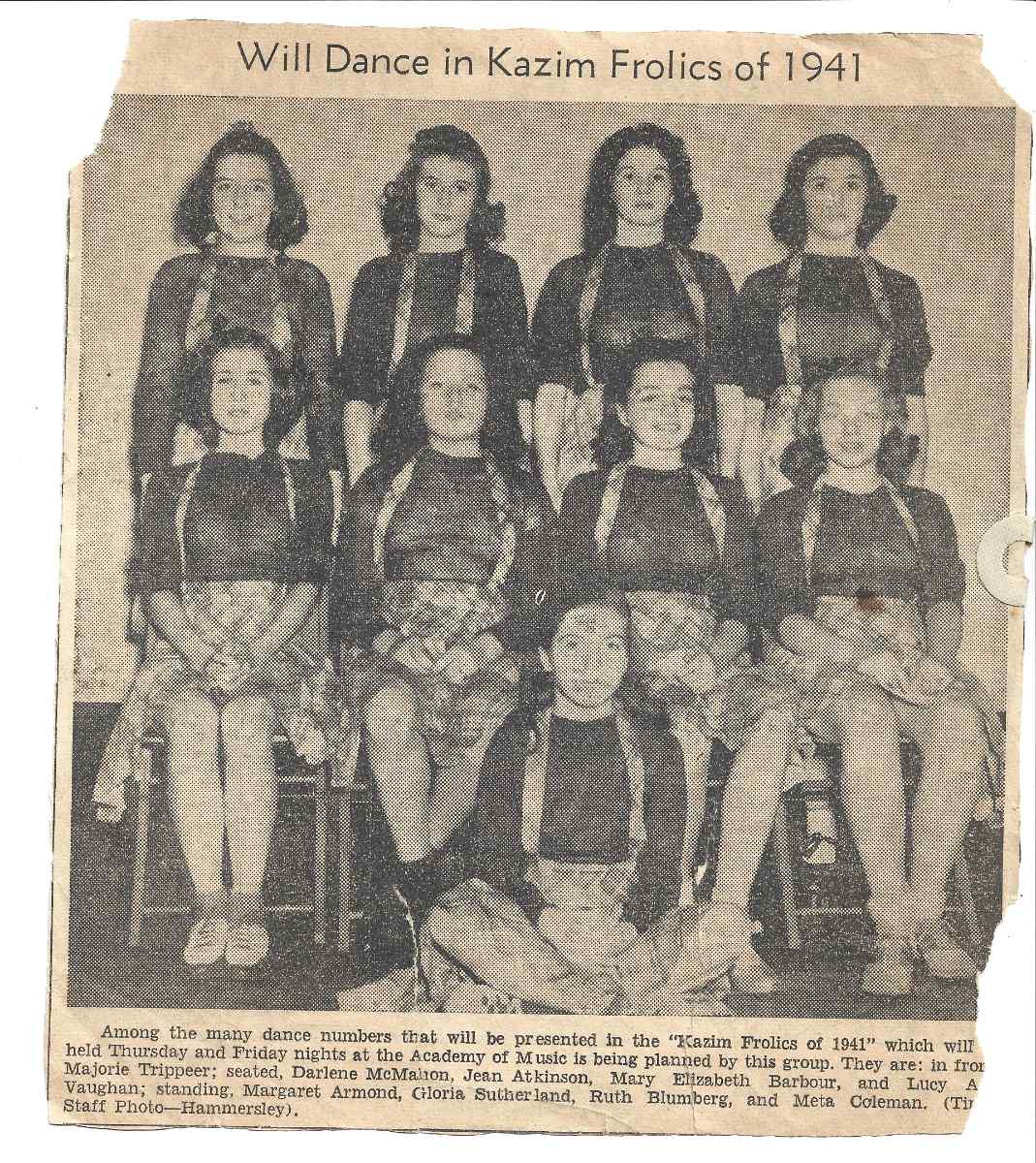
Marjorie Katz newspaper clipping of her 1941 dance group, she is on top row, second from right
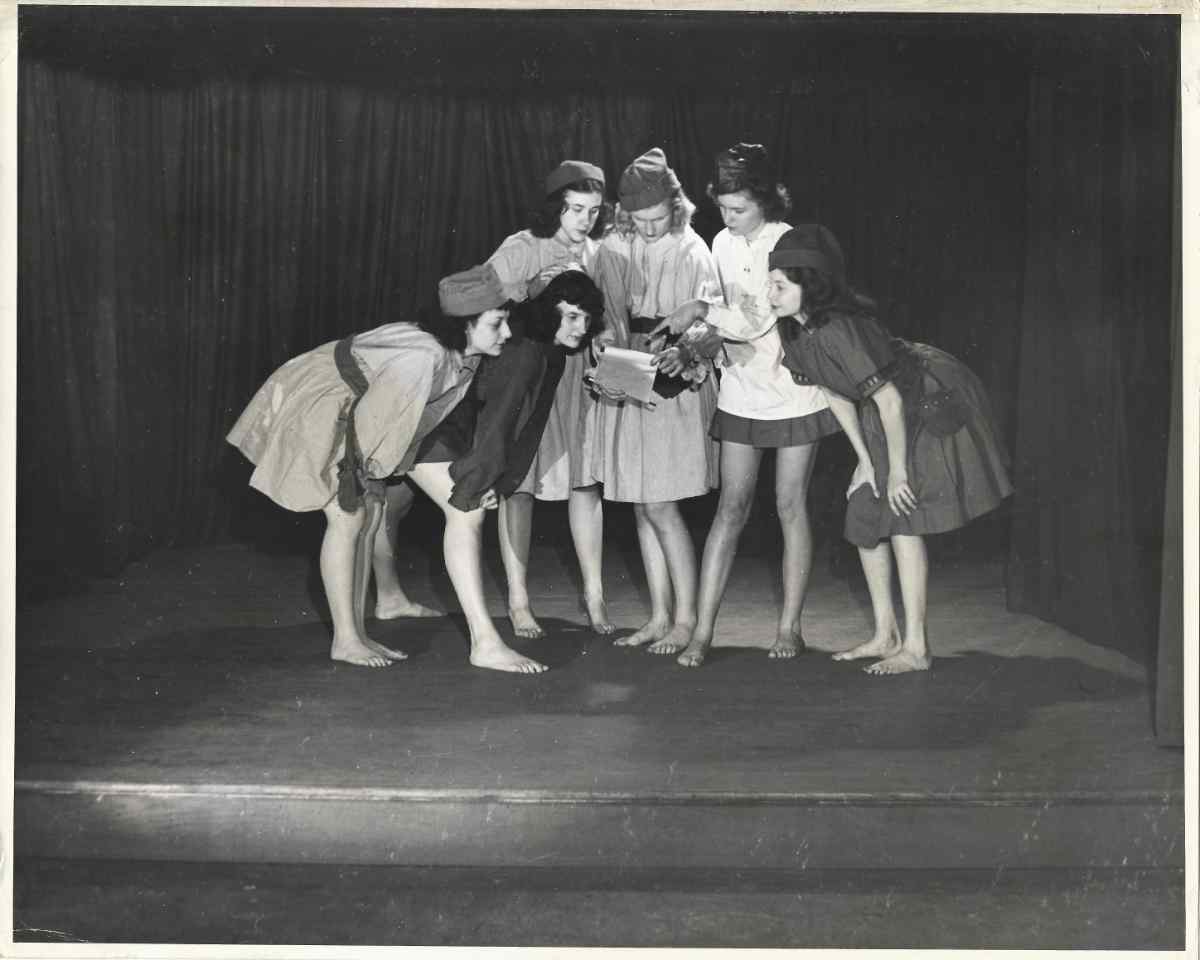
teenage Marjorie Katz with dance group, she is on far right
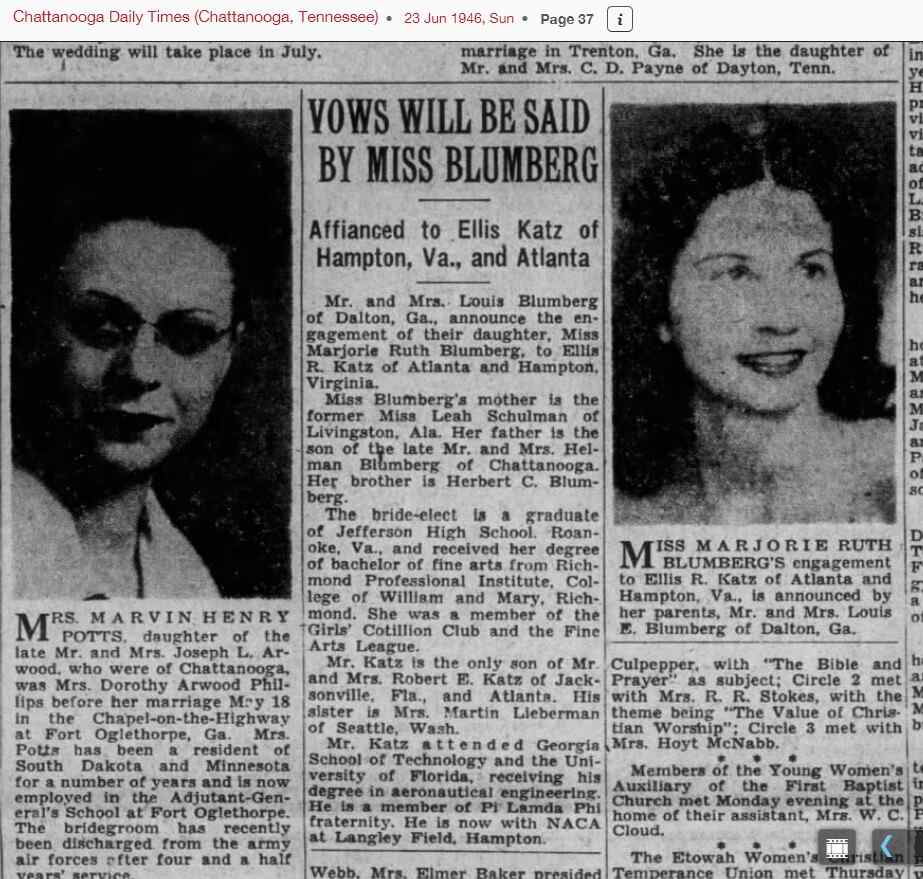
Marjorie Katz wedding announcement
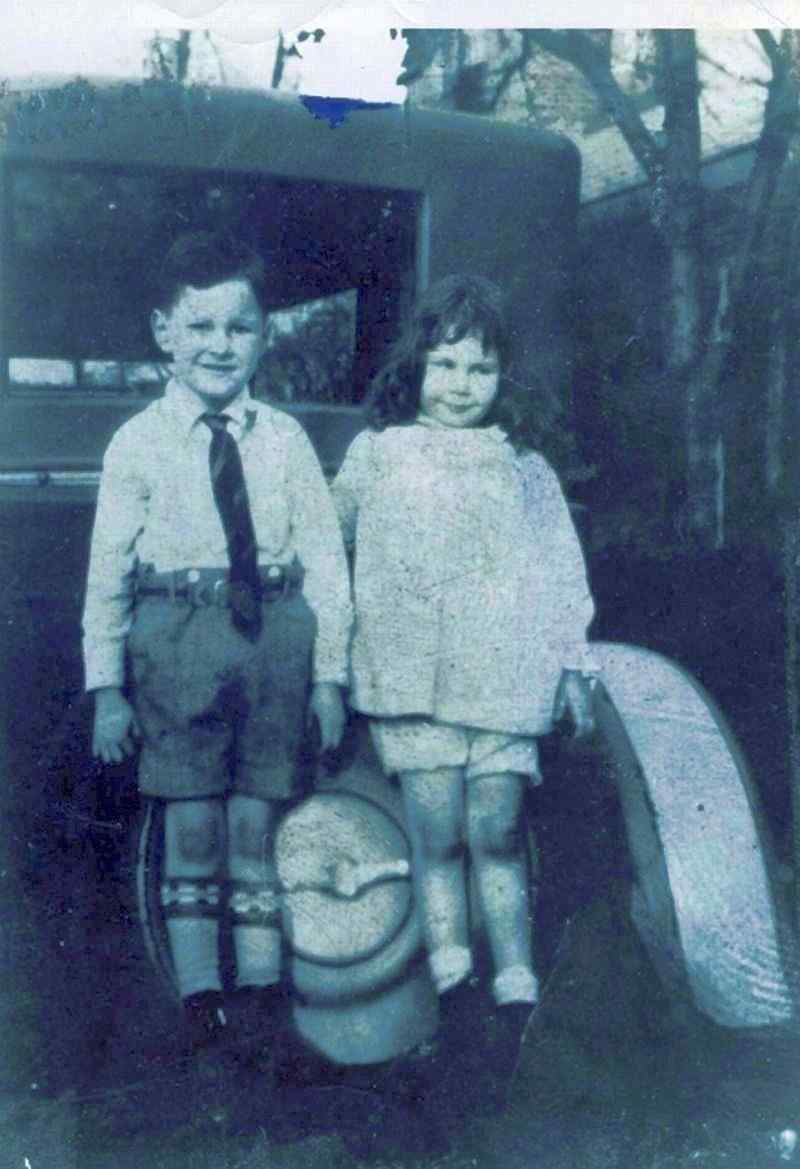
Marjorie and Herbert Blumberg
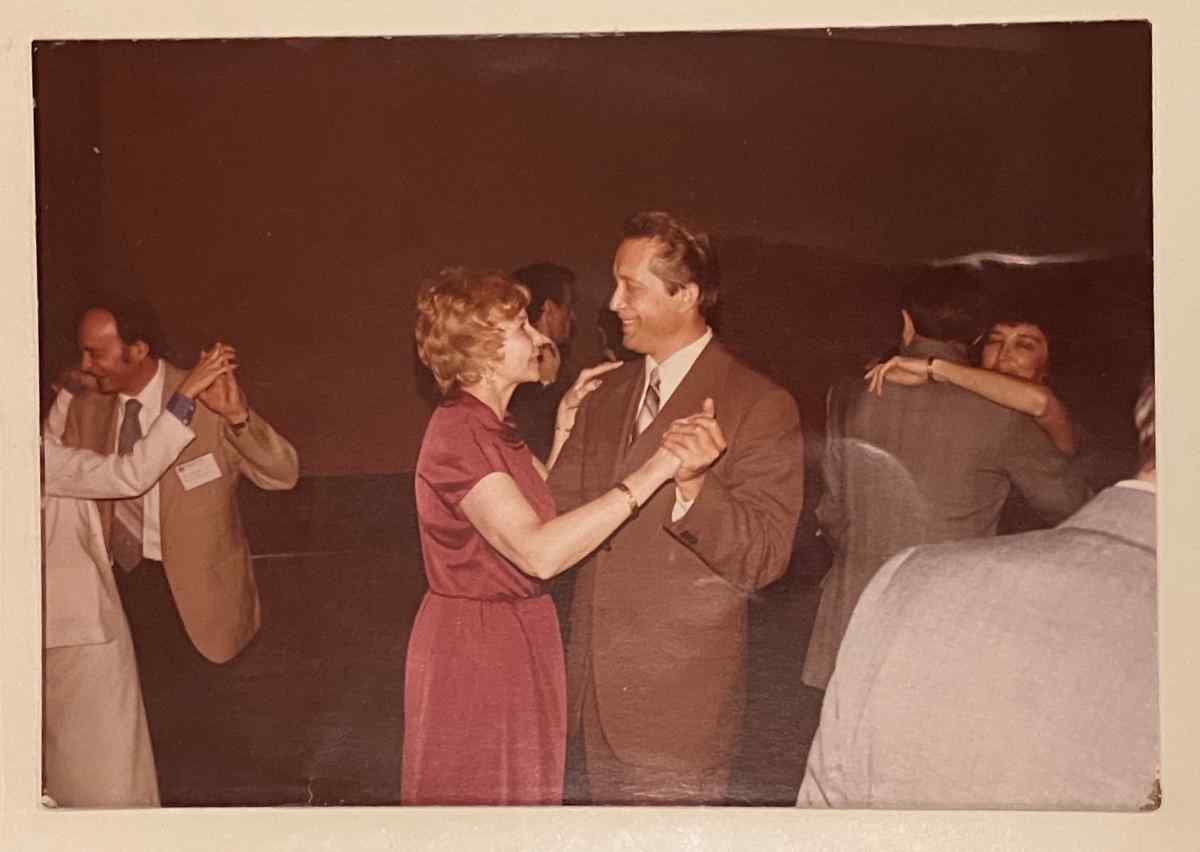
Marjorie dancing with a Russian cosmonaut
Essay by Marjorie on "the influence of a good Jew on his community", 1940
The Influence of a Good Jew on his Community
The distinguishing mark of the good citizen, regardless of race, color, creed or position in life, is his willingness to accept the responsibilities of his citizenship. The merit of a modern man’s citizenship is the extent to which he realizes the necessity of co-operation in community life. Whether one likes it or not, each literally works for all and all for each. To ignore or attempt to cut the subtle connection of this economic unity is not to preserve individualism, but to lose it in chaos.
Citizenship, if it is to escape being a mere technicality, must be backed by the quality of our day-to-day living. Any frank portrait of the Jew as a good citizen of his community is necessarily filled with exciting variety. With minor changes in the old rhyme, he may be either doctor, lawyer, merchant, chief, rich man or poor man, yet, under all this variety, there is the unity of a single all-inclusive purpose: his share and influence in the life of his community.
What does this imply?
From time immemorial the Jew had had to fight against the fear and antagonism of his Christian neighbor in both social and civic life. Much of this has been caused through lack of knowledge between the two groups. The Christian has felt that the Jew wished to keep apart. One of the most persistent of Christian attitudes toward the Jew is that of curiosity. Only as they come to know each other will they come to share their gifts, their customs, traditions, background and further the development of a fine, true community. They must learn to live and work together. Harmonious, happy community life is difficult unless friendly appreciation is established.
The American of today, and of tomorrow, will want to attain a sympathetic understanding, open-mindedness and tolerance to other people of diverse cultures; thereby enriching his whole life through building of a better community. The barriers that separate them can only be broken through personal contacts.
It is unfortunate that all Jews are judged by the majority of peoples, not individually, but collectively. The good Jew, with the welfare of all Jewry at heart, realizes that, being of this minority group, he must actively meet his non-Jewish neighbors more than half way. In times such as these, when distrust and hate of the Jew is being fostered all over the world, each Jewish person is morally obligated to so live and work in his community as to be a counter-influence against all harmful propaganda. In every phase of community life, be it politics, education, literature, music or social service, the good Jew, through his active participation, does much to overcome any prejudice of his non-Jewish neighbor, and by so doing, further the American ideals of democracy.
The life of the late Adolph S. Ochs, former owner of the New York Times, is, to me, one of the most outstanding examples of the influence of a good Jew on his community. It is not only because of the fact that I was born in Chattanooga, Tennessee, the home of Mr. Ochs, where I remember him visiting our Religious School in the beautiful temple sanctuary which he gave to the Reform Congregation in memory of his Mother and Father; nor is it because of his many worthwhile philanthropies in the United States and abroad for the good of all humanity; but because of the esteem and love heard in the voices of all people when they speak of him. Not only the Jew, but the non-Jew as well, seem to take personal pride and reflected glory in his active interest and work for the betterment of all in his community. Their respect for him was greatly due to the fact that although his interests were varied and wide-spread, he never gave up his religion.
Religion is the basis of all Community life, and the non-Jew has a deep respect for religion and the observance of special holidays. He expects the Jew to use his Temple, not as a building of four walls and a roof, but as a House of Prayer, and he also expects the Jew to observe the requirements of his High Holidays. To see the observance only among a few engenders a distrust for the sincerity of all. Therefore, as a leader, the good Jew must have a knowledge and pride of his heritage, and recognize his responsibility to set an example to bring others into closer and deeper affiliation with the Temple.
Every community has its agencies of relief, support and healing. One of the outstanding traits of the good Jew is his readiness to apply the lessons of the Good Samaritan to modern life. Along with the great philanthropists, we find the name of Nathan Straus, whose gifts were many, but whose greatest service to his community and the country at large was his establishment of the Straus Milk Fund which has saved the lives of thousands of babies. The Boy Scouts of America owe much to Mortimer Schiff, one of its founders and presidents.
All are sharers in the glorious adventure of life in America. It is the task of the good Jew to see that no basic human rights shall be destroyed; that human personality shall be cherished; that all shall continue to live in freedom, to think, write, say and do what they please, so long as the greater social welfare is not menaced; to see to it that none shall be forced to take charity; that all who want to work shall find it and that one’s labors shall bring adequate returns.
Christians and Jews, before the challenge of these common tasks, should be patient with each other, trusting, helping and working together for human liberty, justice and progress in the name of the one Eternal God.
So the good Jew, in his contacts with his Christian neighbors, shows himself a worthwhile, desirable person, reflecting merit not only upon himself, but upon his fellow Jews, and becomes an integral part in the development of his community.
Letter to the parents about Ellis, dated May 6, 1946
page 1 page 2 page 3 See Ellis's letterSunday night
Dearest Mother,
Well, my mind's made up, I'm definitely madly in love with Ellis and I'm going to marry him. You & Daddy may think I'm a little hasty especially after the episode with Bill, but honestly Bill couldn't hold a candle to Ellis and I thank the Lord that things turned out as they did. I know when you meet him you'll say the same. I don't think anyone could ever love me as much as Ellis does nor could make me happier. He likes the same people, the same things I do. We have so much fun together and he's so wonderful that you all will be crazy about him.
Irv and Les and Ellis hit it right off this weekend especially Irv & Ellis. Cotillion dance was very nice & Joan & I got orchids from the boys. At the dance Ellis went over & spoke to Mrs Chaeney & asked her to dance etc & naturally she went for him right away. First thing this morning she told me how sweet she thought Ellis was and also that all the chaperones commented on my gown & a few other nice things. Today Joan, Irv Ellis & I and Judy and another friend drove to Williamsburg. Well by the time we got there it was so late we didn't have time to do any sight seeing but went to a wonderful place for dinner called The Travis House. First we were served champagne cocktails out in the gardens & then later for dinner we had scalloped oysters as a side dish which were delicious, rare roast beef, candied sweet potatoes, creamed celery, asparagus, and ice cream with fresh strawberries plus a few other side dishes. It was all served by candle light and I must admit very romantic.
Ellis wants to give me a ring for graduation & we're definitely decided we want to get married this summer - of course with the family's permission I just know you all will love him too. I know I'm doing the right thing and there is no doubt in my mind about us. Ellis will want to talk to you & Daddy at graduation so be ready for it.
I'm going to bed now. Have been going hard since Friday so I'm dead tired. Love to you & Daddy & please let me hear from you immediately - also got the box with my dress. Thanks a lot.
Love again,
Ruthie
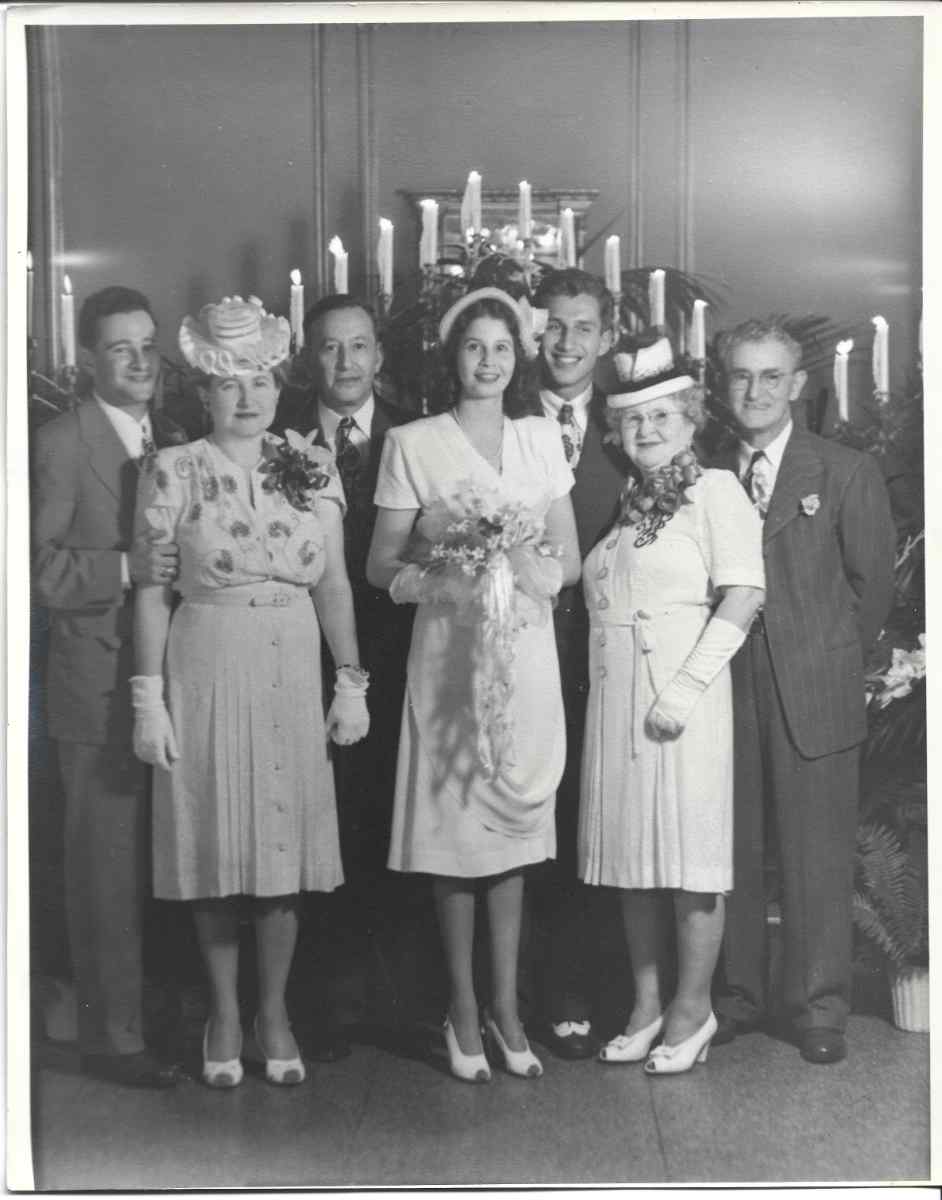
wedding photo of Ellis and Marjorie, with Marjorie's family
This section contains several of Marjorie's poems . Several were written in response to an incident she found amusing or meaningful and reflect a poetic response to that incident. Her poems, given below are, in order:
- "Beragamo Jo"
- "Big Dog Barking"
- "The Crow and the Cottontail"
- "They Come Together"
- "Spring Awakening"
- "Around The Table"
- "I Love My Sofa"
- "Marina"
- "Reflections"
- "What Nature Has Wrought"
- "What Now Leanne?"
- "My Antonia"
- "The Old Yellow Packard"
The Ballard of Beragamo Jo
On one of our evening walks we passed a street called "Beragamo". Somehow that name intrigued me and, later that evening, I wrote my "ballard". [9 Apr 1998]
Beragamo Jo…he aint no mo,
Lived in these here parts
Many a year ago.
Sat on the stoop
Of the general store.
Cursed and spat…
An a whole lot more.
But we all loved him cuz
He belonged to us.
And mosta all,
Were a loveable cuss.
Till the day he died
By a scraggaly few
Who hated Beragamo
For some things he do.
Hanged from a tree
In the courthouse square,
An all us folks cried
When we saw him there.
I was a kid in knickers yet,
But I cried too…
for Beragamo Jo
Who lived in this here place…
An aint no mo.
Big Dog Barking
While Ellis and I were walking one morning, a big dog was standing behind a gate, barking. I thought of Ron and Mikey who, at that time were traveling out this way in his van. [9 Dec 2001]
What or who catches the get-up and go of Mikey?
The Master's voice or the unknown one?
To wag a tail or secure the boundaries: bark!
The Master's voice gives a whistle sharp
And Mikey hears the command of voice.
Bounds to his side and with a lick of hand
Ready for any given command.
BIG DOG BARKING down the trail,
Hunts for varmints, rabbit, or quail.
Time to show what he can do…
Get up and go, Mikey and Master
WHAT A HAPPY DAY!
The Crow and the Cottontail
I saw this strange happening while playing golf at the Calabasas Golf Club. I just stood and watched as long as I was able till Ellis called me to the next tee. [9/13/2001]
Eye to eye the supposed foe come together…a blink apart.
The jet-black crow and the wee baby rabbit…
Joined together in a moment of time.
The cottontail to feast on a new-found morsel…
The crow…all-knowing…to watch.
They Come Together
Marjorie wrote this during the Sunday morning of 3/6/06 while Ellis and Son, Dan, flew in Dan's plane to Santa Paula airport where antique airplanes were on display..
Danny is flying his very own plane,
His dad with him to check out the scene.
A bonding in the sky as clouds scatter round…
And love of mechanics, with a whisper of God.
They come together in mind and the beauty of the Day.
With love for my Sweetheart and our Son 3/5/2006
Spring Awakening
Looking out our bedroom window, I saw two beautiful flowering pear trees in full blossom. [Feb 2009]
What nature has wrought
I cannot compare
The snow-like balls
That fill my eyes with such delight.
I open the shutters
To see a new day
And the brightness of white
Fills my eyes with such delight.
Two flowering pear trees
Ages old.
Bless us with beauty
And their dignity
As blossoms unfold.
Reaching up to the heavens
And giving all to see
What nature has wrought
This gift has been
Given to me.
Around The Table
[Recited to her Family at Brunch on Her Birthday 3 Feb 2012]
Where do I find that special togetherness?
Around the Table.
So many thoughts of love, happy times…
Around the Table.
Thanks for this day: our Beautiful Family…
It all comes full circle…
Around the Table.
Thought for today:
As you planned this celebration..
I am so thankful.
We come together…
Around the Table
I Love My Sofa
I love my sofa…
Not that it is so beautiful…
It is not.
Just a multicolored material…
With three cushions.
In fact this sofa is…
Over fifty years old.
When I bought it,
This piece of furniture…
Had wrought iron arms…
That were later made…
Into a more conventional…
Addition to our den surroundings.
I love my sofa…
When I come home
… It is waiting to relax and…
Comfort me.
First I'm going to sit down…
Remove my shoes…
And then watch…
A special TV show.
After a while…
Having seen Jim Lehrer News Hour…
And a bit of Antique Road Show…
I lay down for maybe…
A quick snooze.
Then my sofa encompasses me…
With the back part against my side.
Oh! What a comforting feeling!
I'm always so glad to know it's there…
To receive me!
Marina 4/17/2012
An Adorable smile…
A Twinkling laugh…
That's what our Friend, Marina is about.
She's always upbeat… Tho' I'm sure, at times down…
Because Marina hears other's woes…
And must listen with comforting words
As they expound…
What are her feelings, her cares???
Will anyone else know?
Reflections 30 Oct 09
It comes to me,
As I sit here daydreaming…
That Poetry is a wonderful Art.
I can express my feelings,
And let the thoughts drift
Throught me.
Poetry relaxes my whole being…
First, I'm in a reflextive mood…
Is Life passing me by?
Age and pain are a part of this process…
Perhaps it comes together as I sigh…
And let my daydreams turn to Poetry.
I think of Family and Friends…
I reflect on this day.
All these thoughts meld into a…
Beautiful; Daydream
What Nature Has Wrought
What nature has wrought
I cannot compare…
The snow-like balls that
Fill my eyes
With such delight.
I open the shutters
To see a new day…
And the brightness of white
Fills my eyes with such delight.
Two flowering pear trees…
Ages old,
Bless us with beauty
And their dignity…
As blossoms unfold.
Reaching up to the heavens
And giving all the see
What nature has wrought…
This gift has been given…
To Me.
What Now, Leeann? What Now….
She poises her brush for the next colorful stroke,
Her canvas is full of many hues…
That surprise and question…
To where from here?
Knowing with certainty
Life's many turns,
The artist seeks a special moment
To reveal a new chapter.
What now, Leeann, what now?
Mar 15 2009
My Antonia
The phone rings…
I answer…it's You Antonia
Your warm sweet voice brings many thoughts to mind:
When i had my knee surgery…
You came and brought my friend, "Mr. Poo"
To keep me company.
Antonia, you are a blessing to me…
And to the many who know you
For your kind and loving thoughts.
The Old Yellow Packard
The old yellow Packard…
was the best that ever was.
As we rode out to the country side…
on a Sunday afternoon.
Me, behind my Father…
as he drove his family…
With my Brother behind my Mother
The windows down, and the fragrance…
of the new-mown hay.
… Comes a Sunday, I think about those days.
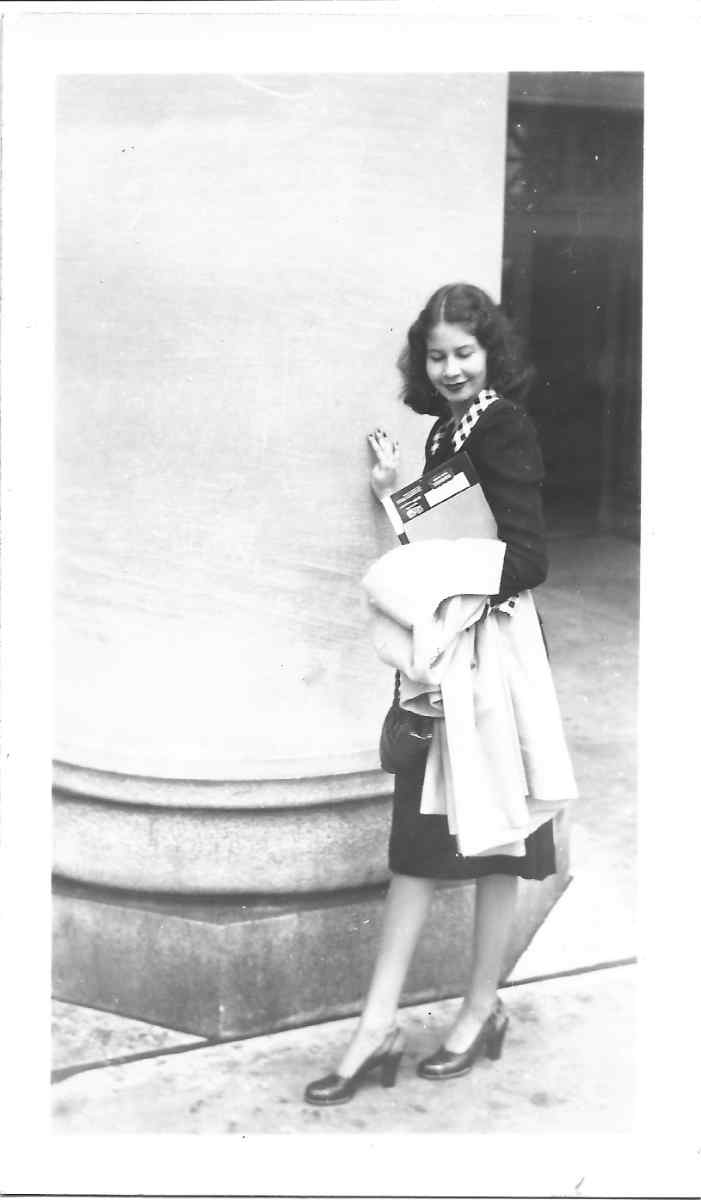
Marjorie posing
Extra information may be sent or requested by emailing the site administrator.